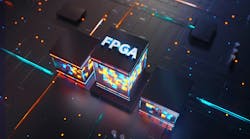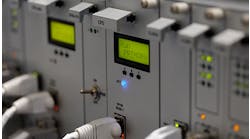Many industries support the popularity of field-programmable gate arrays
A Control Design reader writes: I know field-programmable gate arrays (FPGAs) are widely used in aerospace manufacturing, where rapid prototyping, easy debugging and lower risk of product obsolescence are often a priority. What are the other advantages or disadvantages? Do the advantages of FPGAs translate to other industries, where high bandwidth/low latency/real-time data processing are keys to success? We have used application-specific-integrated circuits (ASICs) for complex systems, and would FPGAs be an alternative there? What should machine builders understand about designing with FPGAs, and what do they pass onto end-user customers in order to reconfigure or reprogram for specific applications?
Answer
FPGA flexibility and popularity
Thank you for your question, as it is timely to understand the events of the past two years. When you mention the use of field-programmable gate arrays (FPGAs), you touch on the most obvious reason for their popularity—their versatility. We will go into this in more detail. You also mention their use in aerospace, but they are widely used in other industries as well.
FPGA supply chain challenges: Field-programmable gate arrays are extremely flexible; therefore, they have been adopted in telecommunications, aerospace and defense, automotive, industrial automation, medical devices, financial services, scientific research, video and graphics, data management, Internet of Things (IoT), consumer electronics, energy and utilities, networking, wireless communications, automated test equipment (ATE), audio processing and avionics. We can address the benefits of these industries with FPGAs, but you can already see one obvious downside. In my opinion, the FPGA was a key enabler after the global health crisis of 2020, which led to the supply chain issues of 2022 and 2023. The demand from all mentioned industries combined with the time required to produce the necessary FPGAs created a situation where products in all industries simply could not be produced. We are now just seeing situations being resolved, and this required redesign of the types of components used in many industries.
What are the advantages of ASICs? Why do all industries like the field-programmable gate array so much? How did this situation happen in the first place? When you consider three different approaches for chip design in electronic systems, it will always be about what goals you are trying to achieve.
Application-specific integrated circuits are faster and more powerful and even smaller. So why not use more ASICs? They are also a custom-made chip design for a specific thing, so they are more expensive and take longer to produce. You are going to use an ASIC for specific high-volume tasks such as digital signals, encryption and graphics.
SoCs with FPGA and ASIC processing: The second approach is the system-on-chip (SoC). This is an advanced approach that combines processing, memory, peripherals and other functions on the chip. An SoC can even have FPGA or ASIC processing onboard. So why not use more SoCs? They are very complex to design and test. They may encounter scalability issues with components. Typically, SoCs are used in advanced applications such as smartphones, tablets or wearables.
FGPA advantages and industry use: So why are FPGAs so popular? It is a chip that offers users an array of logic blocks to program in the manner they choose. They can have memory, I/O and other resources at their disposal to interface with external components. They can be reprogrammed or updated for new firmware or added functions.
What are the advantages of the FPGA? Let’s consider how they are used in different industries and products.
• Telecommunications make extensive use of FPGAs in their infrastructure for signal processing and handling network packets, as well as baseband processing in wireless communications.
• Aerospace and defense like FPGAs for radar, avionics, satellite communication, electronic warfare and military encryption because reliability and customization are critical.
• In the automotive industry, FPGAs are widely used for advanced driver assistance systems (ADASs), infotainment systems, engine control units (ECUs) and in-car communications such as controller area network (CAN) and local interconnect network (LIN).
• Industrial automation thrives on FPGAs for industrial control systems, programmable logic controllers (PLCs), robotics and factory automation for real-time control and data processing.
• Medical devices feature FPGAs in advanced medical imaging equipment such as MRI, CT scanners and ultrasound machines. This technology allows for real-time image processing and analysis.
• Financial services use FPGAs in high-frequency trading (HFT), low-latency data processing and algorithmic trading. Cryptocurrency alone played a large role in the demand for FPGAs as it increased and required more mining processors.
• Scientific research uses FPGAs for advanced physics research, astronomy and machine learning.
• Video and graphics use FPGAs in video processing, compression and acceleration, so they are widely used in gaming consoles—this is another area of high demand.
• Data centers use FPGAs for acceleration to perform encryption and compression, as well as machine learning.
• IoT (Internet of Things) uses FPGAs in smart devices for data pre-processing, encryption and custom protocols.
• High-end consumer electronics use FPGAs for devices, such as 4K televisions and open-platform gaming systems, as these devices also require graphics processing and hardware acceleration.
• Energy and utility companies utilize FPGAs for smart grid systems and power distribution equipment to allow for real-time monitoring and control.
• Networking systems make use of FPGAs in routers, switches and firewalls for packet processing, traffic shaping and network security.
• In wireless communications, FPGAs are widely used for base station control, such as channel coding, modulation/demodulation and beamforming.
• In automated test equipment (ATE), FPGAs are used in testing and quality control of semiconductors.
• In audio processing, FPGAs are used in high-end audio devices to process digital signals and provide audio effects.
• Avionics uses FPGAs in both defense and commercial avionics systems including navigation, communication and flight control.
As you can see, the use of FPGAs already exists in every form of electronic control. The adaptability and ability to reprogram FPGAs make them valuable in scenarios where specific functionality needs to be customized or optimized for desired tasks. This makes them the preferred choice in so many industries. The drawbacks of the FPGA are that it is less efficient and more expensive than the ASIC. It also has lower performance and higher power consumption than the ASIC. However, if you are looking for a device for dynamic applications, such as prototyping, testing, research and development, or want to upgrade the product, the FPGA is an excellent choice.
Perry Hudson, market manager, packaging / Pepperl+Fuchs





